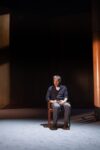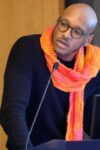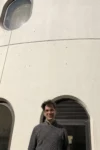 The subtitle of Imani Perry’s Looking for Lorraine is very well chosen — The Radiant and Radical Life of Lorraine Hansberry. Though she succumbed to pancreatic cancer at the age of 34, Lorraine Hansberry was at the center of so many political, cultural, and artistic currents that refashioned American society throughout the 20th century. She wrote criticism for Paul Robeson’s Freedom, studied with W.E.B. DuBois, formed a trinity of committed artistic practice with James Baldwin and Nina Simone, challenged Robert Kennedy on symbolic as opposed to substantive racial politics, jousted with Normal Mailer, Jean Genet, and Amiri Baraka in the public square, challenged sexual norms before mass mobilization around this issue, and of course brought black life (in an honest as opposed to a distorted way) into the theatrical mainstream with A Raisin in the Sun. Despite swimming within these powerful currents Hansberry’s radiance guaranteed that she was always a beacon for those grappling with these complicated times, never subsumed by events or her contemporaries. And as to her radical credentials, Perry writes that though Hansberry “was an internationalist, and something of a Black nationalist, a Marxist, and a socialist, she was also deeply American.” She shines forth as an inspiring bridge between the old style militancy and radicalism of the 30s and the concerns that were to drive the Black freedom struggle and the New Left after her death. Addressing her white comrades regarding the CORE Stall In, she wrote that their main task was “to stop being a liberal and become an American radical,” words which resonate very powerfully in our day.
The subtitle of Imani Perry’s Looking for Lorraine is very well chosen — The Radiant and Radical Life of Lorraine Hansberry. Though she succumbed to pancreatic cancer at the age of 34, Lorraine Hansberry was at the center of so many political, cultural, and artistic currents that refashioned American society throughout the 20th century. She wrote criticism for Paul Robeson’s Freedom, studied with W.E.B. DuBois, formed a trinity of committed artistic practice with James Baldwin and Nina Simone, challenged Robert Kennedy on symbolic as opposed to substantive racial politics, jousted with Normal Mailer, Jean Genet, and Amiri Baraka in the public square, challenged sexual norms before mass mobilization around this issue, and of course brought black life (in an honest as opposed to a distorted way) into the theatrical mainstream with A Raisin in the Sun. Despite swimming within these powerful currents Hansberry’s radiance guaranteed that she was always a beacon for those grappling with these complicated times, never subsumed by events or her contemporaries. And as to her radical credentials, Perry writes that though Hansberry “was an internationalist, and something of a Black nationalist, a Marxist, and a socialist, she was also deeply American.” She shines forth as an inspiring bridge between the old style militancy and radicalism of the 30s and the concerns that were to drive the Black freedom struggle and the New Left after her death. Addressing her white comrades regarding the CORE Stall In, she wrote that their main task was “to stop being a liberal and become an American radical,” words which resonate very powerfully in our day.
Imani Perry is the Hughes-Rogers Professor of African American Studies at Princeton University who, in addition to Looking for Lorraine, has recently published May We Forever Stand (about “Lift Every Voice and Sing,” which was embraced as the Black national anthem) and Vexy Thing: On Liberation and Gender. I sat down with Imani Perry at Uncle Bobbie’s Coffee & Books in Philadelphia to discuss Hansberry’s strain of radicalism, her essential role as a Chicago artist, and how she realized such a full life in 34 brief years.
Michael Schapira: You’ll have to indulge my first couple of questions. It’s one of those weird quirks where you just read something and then read something else right after. Over the summer I read The Cultural Front by Michael Denning.
Imani Perry: He was my professor. I took cultural theory with him.
I thought that might be the case. The Cultural Front is mostly about the 1930s and the cultural productions that were attending popular front politics. When I was reading your book Lorraine Hansberry seemed like a figure out of time in some ways. She seemed much closer to these figures in the cultural front — she studies with DuBois, she works with Ruby Dee, who comes out of the Federal Theater Project, and so on. I was curious how you were thinking about her in relation to this older tradition. In the beginning of the book you wrote about a “flatness” that we attach to figures like her, and it seems like a more general flatness about that long stretch between the 20s and 30s and the 50s and 60s.
Absolutely. The first thing I ever wrote about Hansberry (it was actually my job talk at Princeton) was about cultural policy associated with the popular front and the WPA, and how that created a foundation and possibility for someone like Hansberry to emerge. So it was very much right in that wheelhouse, that this is actually what produced a figure like her. It’s also reflective of my training in Birmingham School cultural studies.
There were the theater groups of the time, but also the writers groups in Chicago…
…She had a natural access to a leftist education without having to go to school.
She had Ray Hansbrough upstairs in her apartment building, and her uncle [William Leo Hansberry], and her uncle’s friends, Dubois, Robeson, and that entire world. She’s uniquely attached to that older generation.
I have a particular interest in attending to black internationalism, black leftist internationalism, in ways that have been neglected. Both a history of the black left and the way black politics existed in general between 1930 and 1968 has been flattened partially because of the traditional narrative of the liberal Civil Rights Movement.
I never published that first piece on Hansberry, but it’s good that you saw it in there.
She’s a very singular figure in many ways, but part of it is that slippage between different times. If she’s drawing on that older internationalist tradition that comes out of a popular front politics, in the chapter on the trinity with James Baldwin and Nina Simone she’s also in a way pushing past the Civil Rights era in a different direction.
In the book you write that the mood of Baldwin and Simone darken after the crest of the Civil Rights Movement, or at least the reception of them darkens. Lorraine Hansberry sadly dies before that crest happened. You spent so much time thinking with her and thinking through her with these other figures. This is purely speculative, but what do you think her mood would have been in that period with Baldwin and Simone in mind?
I don’t know. I have thought that she might have become an ex-patriot. I could see her having gone to Tanzania, like a number of people from SNCC did. Though I think it would be more likely that she would go to Latin American or the Caribbean, because she was a real Americanist.
She was so critical even in the early 60’s of the liberal mainstream of black politics, that she would have had trouble with the shift to a focus on electoral politics and building power within the Democratic Party. That would have driven her crazy.
There is that great quote in the book (though she’s talking to white people) to “stop being a liberal and become an American radical.”
Yeah. But she was also haunted by the struggles of her father, even though she differed from him politically. [Carl Hansberry died in Mexico, after exploring plans to move his family there.] By virtue of being the child of a migrant, she understood something deep about all these spaces that were supposed to be hopeful. She saw the virtue in his American dream. But she had no fictions about desegregation being a panacea or achieving mainstream power, black faces in high places, or anything like that being the path to freedom.
I think it would have been quite difficult, especially with all of the death. Although I do think she would have been very excited by the rise of black feminist politics in the 70s were she around.
It’s funny you mentioned migration because that is the next thing I wanted to ask you about. Again, thinking about the 30s a lot of the far left politics is driven by the children of migrants or comes after a big wave of migration. Her story seems very much in line with that second generation after migration. You introduce the theme in the second chapter of the book. Why did that seem so important to insist upon in setting up her story?
Some of it is my own interest in centering Chicago in black studies. A lot of the book takes place in New York, but I think New York takes up too much space in black studies. Chicago is defined so much by migration. New York has a very small group of people who are cultural workers, and they do amazing work, but Chicago is so expansive — it’s music, it’s art, it’s literature, it’s business — it’s all these arenas, but it’s also the site of the dream and its deferral. Because she’s such a Chicago writer this seemed important. She talks and thinks about it, but then at the end of her life what she’s yearning for is to go south and she runs out of time. She’s a second generation Chicagoan, but then she is so profoundly inspired by the southern movement and this idea of return. In some ways she was also ahead of her time in that respect because once you get to black power and black consciousness movements, you see this whole thing about return. She’s thinking about the politics of return already.
Another Chicago connection can be seen in these new Studs Terkel interviews that are available online. There is one with her that I listened to last night.
That’s great. It’s funny, there are some differences between the book that he publishes of all the interviews and the actual interviews themselves. Some are pretty substantial, so it’s great to listen to it. She loved talking to him.
You can tell. One thing that really comes out in that interview is her role as a critic. I knew a little bit about her politics, a tiny bit about her artistic production, but her critical work was one of the biggest discoveries in the book. Was this vast body of criticism a discovery for you in the research process?
It’s funny. My dad actually used to use quotes from her. He was an epidemiologist and he wrote about racism and public health, so through his quotes I knew some of her social criticism, but not the literary stuff, and certainly not of her own work.
She seemed to really like criticism. He can see it in her letters. Her coordinates are De Beauvoir, Genet, and the Sartre/Camus split. She has all of these strong things to say in favor of realism over naturalism.
Yes. She saw naturalism as reductive and unimaginative whereas realism, for her, included a belief in the power of the imagination.
I had a question about the archive that is related to this. What was the status of materials available to understand her life a decade ago verses today?
A lot of it wasn’t accessible. It’s still the case that not everything is in the archive, although it’s huge. There are her letters, and I dealt mostly with those and other things at the Schomburg Center, but there is also a photo archive and one with sound and digital materials. It’s so vast for someone who only lived 34 years, it’s really quite extraordinary. To write about her you really have to be in the archives for years before you can even begin to know what you are going to say.
This is maybe too big a question, but it was something I was thinking about as I was reading the book. In many ways her life is obviously incomplete and she’s working right up to the end and has so much more that she wants to do. But she’s also so present in everything that she is doing, even in coming to terms with her own illness. Do you think it makes sense to say that she lived a complete life?
I do. I feel like it’s an uphill battle and I’m pushing against a dominant interpretation. Her early death was so tragic; there is an overwhelming feeling of the tragedy and the heartbreak of her death for so many people. But she got so much done and lived a huge life. So I don’t have as much of the “what if” feeling that others do. I think she did a lifetime of work.
You spent a lot time going through letters and journals and it’s such an intimate process. There are parts of the book where you are comfortable doing interpretation, and then there are certain times when you pull back and say it’s not your place to do it. Did it take a little feeling out to understand where that line was?
There are subjects where there is enough repetition of an idea that I really knew what she is getting at. Then there are other subjects where it was still opaque. For me part of the process is to leave space for the reader, to step back a bit.
One of the things I think a lot about with respect to the question of the archive, and increasingly now with many questions about completing archives, is what to do with absences and gaps. I think pursuing that question is a really useful endeavor. And I think its part of a way to write that is an invitation, for the next book and the book after that, to grapple with material in different ways. I also wanted to make it transparent that there is some ambiguity in the process, and that this is a work of discovery, not necessarily authority.
Every book or article I write I think of as an exercise in method, as creating an artifact. It’s exploratory in thinking about how am I going to answer this question.
It’s interesting that you say that. You have published three books this year. If you’re thinking of each one as an exercise in method, how, if at all, do they interpenetrate one another? The book on the Black national anthem [May We Forever Stand] seems to go back to that popular front historical stuff, and the book on gender and liberation [Vexy Thing] is clearly part of Hansberry’s story in an important way.
In May We Forever Stand the anthem is a vehicle for talking about black associational life and formal culture. That I think is a story that has been missing in African American studies. We focused a lot on the vernacular in really wonderful ways, but not about formal institutions and associational life, and that’s really key for understanding how movements happened. That associational life is part of how Hansberry is socialized.
As for the book that is gender theory, in some ways Hansberry is an exemplar of trying to work through the structure of patriarchy. When she’s trying to make sense of empire and gender and sexuality and capital, all these sorts of things, she anticipates in many ways what I’m trying to do, but is also an exemplar of that effort to think through domination, to think through relations of power. So in some ways she’s at the center of these two other projects.
It’s all part of trying to make sense of things that I understand but that academia at present hadn’t really answered. So I want to make the case.
Do you ever have your students in mind when going through these projects? I’m teaching “Letter from Birmingham Jail” next week and there is definitely a flatness in the way that students understand that history.
Especially Birmingham. That’s where I was born. I got so furious when the news coverage of the 55th anniversary of the 16th street bombing had a pundit who said, “They killed these four little girls and the people didn’t respond angrily. They responded with peace.” That’s just not true. There was a riot in Birmingham. I know people who lived on“Dynamite Hill” where men patrolled every night with guns to protect themselves from white violence. The passive narrative is false, and it has the effect of making the movement sentimental as opposed to tactical.
There is something interesting about the current moment. There are still those increasingly pathetic attempts to police the history and make it sentimental because there is a political ideology behind that. But then when the Raul Peck movie about James Baldwin came out it was wildly popular (at least in New York, where I was living) because it presented a far more complicated narrative about his own intellectual and artistic projects, but also about that period of time with these big critiques of industry and capitalism. It seems like there is a real desire for these complicated stories now.
I think so. Vexy Thing is the one that is written most explicitly for and towards my graduate students. It’s who I imagine as the primary audience, and part of that is wanting to focus on a more complex story. It’s risky to say this, but I also want to pull back against some of the rejection of metatheory that happened when I was in grad school. Some of the impact of the postmodern turn was that people began to have a lot of difficulty thinking through systems — trying to say, we know that this is contingent, but we also know that these things are tools to help us understand the structures of power. I’m a structuralist in some ways. Not an absolutist structuralist, but I do think that understanding structures are super important. In some ways I identify with Hansberry in that respect.
To shift back, there is one thing that I think I missed in the book that maybe you can fill in for me, and that is where her love of theater specifically emerged. She talks about her love of Sean O’Casey and in the Studs Terkel she really shows that she knows the history and the theory of theater up and down. But she also seems like someone who is pushing for expression in all kinds of different directions, and theater seems to be the one that took. I missed why it was theater above all else.
I don’t know, and that’s part of the reason why I don’t answer the question. What my gut says is that she’s interested in being a critic and a theorist. She’s really taken by the visual, and she’s really taken by social questions. Her politics are all about community, and there’s something about the way that theater is this multi-sensory experience and can capture all of this. She is so critical of herself for never having any central characters, but I think that’s actually precisely why theater works for her. There is the visual piece, but there are all of these ideas that can collide so that it’s like actually having on intellectual debate on stage.
That seems compelling. In that Studs Terkel interview she says that she wanted a ballet in the center A Raisin in the Sun. At the end she says she’s working on librettos for opera, but is hesitant to say more, but you can see that total vision at work.
The visual is so important to her. Her stage directions are like little short stories. You could read them as a separate work of literature.
Because of these new archival materials you have access to all kinds of fragments and sketches for future projects. Were there one or two that stuck out as particularly tantalizing?
Oh god, there were so many. Soyica Colbert is a professor at Georgetown who is writing a book on her. We would like to work together to put together a Hansberry reader that has fiction, non-fiction, and other plays, because there is so much that is so good.
I’m not familiar with Les Blancs [the third major play of Hansberry after A Raisin in the Sun and The Sign in Sidney Brustein’s Window]. How complete was it?
There are disagreements about this. There are at least four different versions. She considered it incomplete, but I consider it a complete work. There is some skepticism about [Robert] Nemiroff [Lorraine’s husband] finishing it. It really is a point of interpretation. His finishing the play wasn’t writing whole new scenes or making a better ending. It really was wading through the different drafts to make it cohere, so it’s not like it’s not her work and ideas and formulations. I’m not a theater studies scholar, so other folks might disagree, but I think it’s quite complete. But also historically it is really meaningful. It is one of the first plays in that genre of anti-colonial plays.
It’s probably out of place to ask what’s next because you’ve just finished three projects at the same time. But is that reflective of your working habits, that there is always something else going on?
Yeah, I’m working on a bunch of stuff. I have another project that is coming out soon which is a creative non-fiction thing. That’s all I’ll say about that right now. I never published my doctoral dissertation and at some point I’m going to write a book that is about law in the black American literary imagination which is related to my dissertation. I’ve been teaching and writing on that subject now for 22 years so it’s really a matter of finding a time to sit down and write it all out. It will go from David Walker and Frederic Douglas to Morrison , and explore questions about what law is and does, what it should be, and those sorts of things.
Michael Schapira is an Interviews editor at Full Stop and teaches Philosophy at St. Joseph’s University.
This post may contain affiliate links.







